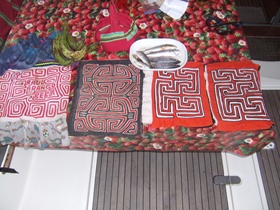Carreto 8:46.48N 77:38.92W

Pacific Bliss
Colin Price
Tue 28 Sep 2010 14:50
|
Carreto
I would supply more photographic evidence of Carreto but after
going to check-in and ask the chief/Silas if we could stay, ohh and part
with the manditary $5 otherwise known as 'Kuna Tax', we where then told,
"Carreto is not a tourist town and wishes to remain this way". All very cool
with us as we know culture in the San Blas is rapidly ebbing away, we
just felt lucky to see it. There are 5 silases in Carreto and we had the
pleasure to meet two, but we were then restricted to only walking the
streets and be back on our boat by dark. Before the village meeting
each night which starts at 6, we understand this is when
the village elders lye in the centre of a large community
meeting hall with the village folk sitting all around on
benches, this too is in order of importance, women and children first then
the rable of men pushed toward the back of the auditorium. This is
where the Stories of old and all community issues and concerns are
discussed and like all good communist states it is the 5 boys and the top
luxuriating in the hammock that make any rulings.
As Carreto is not a tourist town we where not permited to take
photographs or visit any sacred places like the river or cemetary. What we
where allowed to do was turn into medical professionals. It seems that the
folk of Carreto don't have even the most rudimentary of medicines. We
provided paracetamol for one of the silases sons, the old man looked about
80 and his son about 16 so nothing wrong with his labeido.....
We are beckoned into the Sylas hut by an old toothless lady in
traditional dress and enter into a cavonous dark room, with a about half a dozen
women sitting about on low stools, and swinging from the bamboo rafters 10
dozen mola tops, there we are ushered towards the sick boy who is
swinging on his hamock in the baking heat with a blanket over him and Kuna
herbs strung above him in order to ward off spirits and virus.
The next Silass we visited we where about to provide this old
man with diaretics and I had to give the grandma of an indeterminable age ransid
feet infected feet, it seems bizar to be giving some one of this age a
lesson on how to clean a wound and cover it so as not to reinfect.
We had been told that alot of Kuna Indians especially those in
the eastern more remote villages, had little to no access to things
we count as normal human needs, things like
reading glasses, medicine, clothing for babies, they might
have a two shops in the village selling all things you need to make a
flipping mola (it is law that ladies wear traditional dress) but any pain
releif or sanitary towels for women.
So we had come armed with items to trade of as gifts.
But having left our first Kuna village we where feeling like we needed to
re-evaluate our approach to giving, this time we take the trade route only
it appears we rather useless at this too......
We are ambushed by every lady once word is out we are trading
but not just trading we are only interested in old used molas, by the time
we leave we come way with no reading glasses of which we had a 11 and we are now
the proud owners of 8 really dirty threadbare faded bits of cloth, ohh and a
bunch of plantain and 5 little fish. But the marouding crowds were quite
an experience, but not sure we will be repeating our second approach to
intergrating with the indigenous folk. The kids where now rather nervous of our
visits on to land. And whilst Cosmo ( now known as Cosman) enjoyed the endless
footy and basket ball games in which he was conciderably
lacking when playing with the local boys.
It was a great village and really well maintained.
Dispite being very cut off from any form of running water, light all the
villages seem to have a few Telephone quiosks,but inkeeping with the design of
the village these boxes are disguised by bamboo walls and palm frong roof.
Because there is no mobile reception down here they use the telephones to keep
in touch with friends and family in other parts of Kuna Yala or in Panama.
This is efficiently done by ladies working shift work and mola stiching whilst
watch the phones, and when they ring a local youngster will dash off and find
the required village member. But i just love the fact they cover these
ugly plastic blue boxes up.
Carreto was beautiful and an extremely peaceful place if you
don't try and trade for crappy old molas.
 |